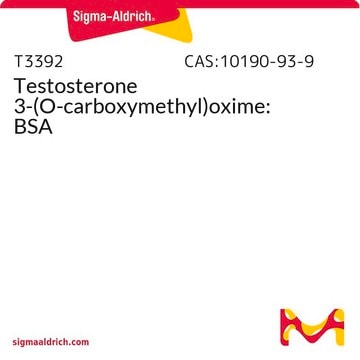T5771
Testosterone 3-(O-carboxymethyl)oxime: BSA - fluorescein isothiocyanate conjugate
About This Item
Recommended Products
assay
≥98.00% (TLC)
Quality Level
form
powder
drug control
regulated under CDSA - not available from Sigma-Aldrich Canada
extent of labeling
~3 mol FITC per mol BSA
~10 mol steroid per mol BSA
technique(s)
flow cytometry: suitable
solubility
water: 1.90-2.10 mg/mL, clear to faintly hazy, orange
shipped in
ambient
storage temp.
2-8°C
Application
Biochem/physiol Actions
signalword
Warning
hcodes
Hazard Classifications
Acute Tox. 4 Dermal - Acute Tox. 4 Inhalation - Acute Tox. 4 Oral - Carc. 2
Storage Class
11 - Combustible Solids
wgk_germany
WGK 3
flash_point_f
Not applicable
flash_point_c
Not applicable
ppe
Eyeshields, Gloves, type P3 (EN 143) respirator cartridges
Certificates of Analysis (COA)
Search for Certificates of Analysis (COA) by entering the products Lot/Batch Number. Lot and Batch Numbers can be found on a product’s label following the words ‘Lot’ or ‘Batch’.
Already Own This Product?
Find documentation for the products that you have recently purchased in the Document Library.
Customers Also Viewed
Our team of scientists has experience in all areas of research including Life Science, Material Science, Chemical Synthesis, Chromatography, Analytical and many others.
Contact Technical Service










